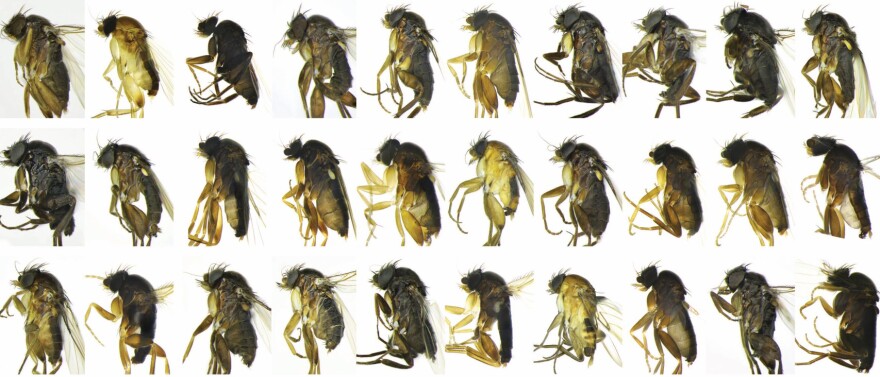With our free press under threat and federal funding for public media gone, your support matters more than ever. Help keep the LAist newsroom strong, become a monthly member or increase your support today during our fall member drive.
30 new species of fly discovered in Los Angeles

Los Angeles must be feeling pretty fly today.
That's because a recent survey by the Natural History Museum of LA County found 30 new species of fly living in the region.
"I kept checking and rechecking my work because I couldn't believe so many were undescribed," said NHM researcher Emily Hartop of the discovery.
These aren’t your typical house fly. They come from the Phoridae family and are in the genus Megaselia.
Each is roughly the size of a sesame seed and range in color from a light yellow to a dark black, though they are often hard to distinguish with the naked eye.
(Los Angeles, meet some of your new species of Megaselia fly: Megaselia mikejohnsoni, M. creasoni, M. francoae, M. donahuei, M. lombardorum, and M. rodriguezorum.)
A new discovery
The bugs were found thanks to an insect survey known as BioSCAN.
30 tent like "malaise traps” were set up around the region, from Glendale to Gardena. Each trap had an alcohol-filled collecting bottle on top that caught the critters.
From there, researcher Emily Hartop took on the grueling task of examining tens of thousands of collected samples to see if they were known or unknown species.
"You embrace the madness," she joked.
Hartop says the most defining feature of these bugs is the male genitalia.
So, using a microscope she studied the reproductive organs of countless flies to determine which ones represented a new species.
(Researcher Emily Hartop became an expert at drawing Megaselia genitals, as evidenced here.)
"I couldn’t really believe it, but it didn’t seem that most of my flies had been studied before," Hartop wrote in a blog post for the museum.
Eventually she travelled to England to meet with Dr. Henry Disney, the foremost expert on these insects. Together they were able to determine which samples represented entirely new species.
The results were published by journal Zootaxa.
In a nod to the citizens who helped this project along, the newly discovered bugs were named after the families who volunteered to have traps set up on their property.
Different flies, different roles
NHM entomology curator Brian Brown says even though these flies are all in the same family, each species often serves a very different function in the urban ecosystem.
They have evolved so that some are predators, some are parasitoids that lay eggs inside other bugs and others are herbivores.
"They have been very successful and largely unnoticed because of their small size," he said.
However, Brown and Hartop have yet to discover the exact role played by each of the newly named bugs.
"These tiny phorid flies are busy all the time, all around us...now we just have to figure out exactly what they are doing!" Hartop said.
Brown thinks the fact there are so many varieties of insect in the region indicates that many of the urban ecosystems are doing quite well.
In fact, he said Los Angeles is particularly well suited to bugs since the weather is temperate and international ports allow many creatures to arrive and evolve here.
"The biodiversity in Los Angeles is large, it's poorly known and is still full of discoveries to be made," Brown said.
At LAist, we believe in journalism without censorship and the right of a free press to speak truth to those in power. Our hard-hitting watchdog reporting on local government, climate, and the ongoing housing and homelessness crisis is trustworthy, independent and freely accessible to everyone thanks to the support of readers like you.
But the game has changed: Congress voted to eliminate funding for public media across the country. Here at LAist that means a loss of $1.7 million in our budget every year. We want to assure you that despite growing threats to free press and free speech, LAist will remain a voice you know and trust. Speaking frankly, the amount of reader support we receive will help determine how strong of a newsroom we are going forward to cover the important news in our community.
We’re asking you to stand up for independent reporting that will not be silenced. With more individuals like you supporting this public service, we can continue to provide essential coverage for Southern Californians that you can’t find anywhere else. Become a monthly member today to help sustain this mission.
Thank you for your generous support and belief in the value of independent news.

-
Metro officials said it will be able to announce an opening date “soon.”
-
While working for the county, the DA’s office alleges that 13 employees fraudulently filed for unemployment, claiming to earn less than $600 a week.
-
The L.A. County Board of Supervisors on Tuesday voted to declare immigration enforcement actions a local emergency.
-
Tens of thousands of workers across Southern California walk out over pay and staffing issues.
-
People in and around recent burn scars should be alert to the risk of debris flows. Typical October weather will be back later this week.
-
Jet Propulsion Laboratory leadership says the cuts amount to 11% of the workforce.







